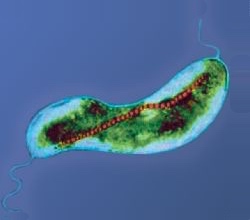
Back بكتيريا ممغنطة Arabic Magnetotaktische Bakterien German Bacteria magnetotáctica Spanish Bactérie magnétotactique French Magnetotaktikus baktériumok Hungarian Batteri magnetotattici Italian 磁性細菌 Japanese Bactéria magnetotática Portuguese Bacterie magnetotactică Romanian Магнетотактичні бактерії Ukrainian
This article is missing information about taxa. (October 2020) |

Magnetotactic bacteria (or MTB) are a polyphyletic group of bacteria that orient themselves along the magnetic field lines of Earth's magnetic field.[1] Discovered in 1963 by Salvatore Bellini and rediscovered in 1975 by Richard Blakemore, this alignment is believed to aid these organisms in reaching regions of optimal oxygen concentration.[2] To perform this task, these bacteria have organelles called magnetosomes that contain magnetic crystals. The biological phenomenon of microorganisms tending to move in response to the environment's magnetic characteristics is known as magnetotaxis. However, this term is misleading in that every other application of the term taxis involves a stimulus-response mechanism. In contrast to the magnetoreception of animals, the bacteria contain fixed magnets that force the bacteria into alignment—even dead cells are dragged into alignment, just like a compass needle.[3]
- ^ Lin, Wei; Zhang, Wensi; Zhao, Xiang; Roberts, Andrew; Paterson, Greig; Bazylinski, Dennis; Pan, Yongxin (26 March 2018). "Genomic expansion of magnetotactic bacteria reveals an early common origin of magnetotaxis with lineage-specific evolution". The ISME Journal. 12 (6): 1508–1519. Bibcode:2018ISMEJ..12.1508L. doi:10.1038/s41396-018-0098-9. PMC 5955933. PMID 29581530.
- ^ Dusenbery, David B. (2009). Living at micro scale : the unexpected physics of being small. Cambridge, Mass.: Harvard University Press. ISBN 978-0-674-03116-6.
- ^ Dusenbery, David B. (1996). "Life at Small Scale", pp. 100-101. Scientific American Library, New York. ISBN 0-7167-5060-0.